Use of Bioproducts Derived from Mixed Microbial Cultures Grown with Crude Glycerol to Protect Recycled Concrete Surfaces
Abstract
1. Introduction
2. Materials and Methods
2.1. Materials
2.1.1. Concrete
2.1.2. Bioproducts
2.2. Treatment of Concrete Surface
2.3. Test Method
2.3.1. Water Absorption under Low Pressure of Hardened Concrete
2.3.2. Water Absorption by Capillarity of Hardened Concrete
2.3.3. SEM and EDS Analysis
3. Results and Discussion
3.1. Water Absorption under Low Pressure
3.2. Water Absorption by Capillarity
3.3. SEM and EDS Analysis
4. Conclusions
- The bioproduct subjected to the sonication process, a process in which the cell walls of the MMC were broken, showed a higher effectiveness than the non-sonicated bioproduct; and
- With the assessment of the behavior of the biotreated concrete specimens over 8 cycles of Karsten tube tests, it was shown that, although the effectiveness of the biotreatment decreases over time, they still showed a high resistance to water absorption when compared to the reference specimens (treated with water), presuming a longer useful life of recycled concrete.
Author Contributions
Funding
Institutional Review Board Statement
Informed Consent Statement
Data Availability Statement
Conflicts of Interest
References
- Wong, W.Y.; Lim, S.; Pang, Y.L.; Shuit, S.H.; Chen, W.H.; Lee, K.T. Synthesis of renewable heterogeneous acid catalyst from oil palm empty fruit bunch for glycerol-free biodiesel production. Sci. Total Environ. 2020, 727, 138534. [Google Scholar] [CrossRef]
- Hamada, H.M.; Skariah Thomas, B.; Tayeh, B.; Yahaya, F.M.; Muthusamy, K.; Yang, J. Use of oil palm shell as an aggregate in cement concrete: A review. Constr. Build. Mater. 2020, 265, 120357. [Google Scholar] [CrossRef]
- Mo, K.H.; Thomas, B.S.; Yap, S.P.; Abutaha, F.; Tan, C.G. Viability of agricultural wastes as substitute of natural aggregate in concrete: A review on the durability-related properties. J. Clean. Prod. 2020, 275, 123062. [Google Scholar] [CrossRef]
- Redling, A. Construction Debris Volume to Surge in Coming Years. Available online: https://www.cdrecycler.com/article/global-volume-construction-demolition-waste/ (accessed on 21 October 2020).
- De Juan, M.S.; Gutiérrez, P.A. Study on the influence of attached mortar content on the properties of recycled concrete aggregate. Constr. Build. Mater. 2009, 23, 872–877. [Google Scholar] [CrossRef]
- Evangelista, L.; de Brito, J. Durability performance of concrete made with fine recycled concrete aggregates. Cem. Concr. Compos. 2010, 32, 9–14. [Google Scholar] [CrossRef]
- Zhao, Z.; Wang, S.; Lu, L.; Gong, C. Evaluation of pre-coated recycled aggregate for concrete and mortar. Constr. Build. Mater. 2013, 43, 191–196. [Google Scholar] [CrossRef]
- Tabsh, S.W.; Abdelfatah, A.S. Influence of recycled concrete aggregates on strength properties of concrete. Constr. Build. Mater. 2009, 23, 1163–1167. [Google Scholar] [CrossRef]
- Kou, S.C.; Poon, C.S. Enhancing the durability properties of concrete prepared with coarse recycled aggregate. Constr. Build. Mater. 2012, 35, 69–76. [Google Scholar] [CrossRef]
- Peled, A.; Peled, A.; Shah, S.P. Corrosion of Steel Bars in Cracked Concrete under Marine Environment. J. Mater. Civ. Eng. 2016, 1561, 192–199. [Google Scholar] [CrossRef]
- Sandra, N.; Kawaai, K.; Ujike, I. Influence of copper slag on corrosion behavior of horizontal steel bars in reinforced concrete column specimen due to Chloride-induced corrosion. Constr. Build. Mater. 2020, 255, 119265. [Google Scholar] [CrossRef]
- Basheer, L.; Kropp, J.; Cleland, D.J. Assessment of the durability of concrete from its permeation properties: A review. Constr. Build. Mater. 2001, 15, 93–103. [Google Scholar] [CrossRef]
- Liang, M.; Feng, K.; He, C.; Li, Y.; An, L.; Guo, W. A meso-scale model toward concrete water permeability regarding aggregate permeability. Constr. Build. Mater. 2020, 261, 120547. [Google Scholar] [CrossRef]
- Freches, A.; Lemos, P.C. Microbial selection strategies for polyhydroxyalkanoates production from crude glycerol: Effect of OLR and cycle length. New Biotechnol. 2017, 39, 22–28. [Google Scholar] [CrossRef]
- U.S Energy Information Administration. Washington DC International Biofuel Production. Available online: http://www.eia.gov (accessed on 18 October 2020).
- Kumar, L.R.; Yellapu, S.K.; Tyagi, R.D.; Zhang, X. A review on variation in crude glycerol composition, bio-valorization of crude and purified glycerol as carbon source for lipid production. Bioresour. Technol. 2019, 293, 122155. [Google Scholar] [CrossRef] [PubMed]
- Quispe, C.A.G.; Coronado, C.J.R.; Carvalho, J.A. Glycerol: Production, consumption, prices, characterization and new trends in combustion. Renew. Sustain. Energy Rev. 2013, 27, 475–493. [Google Scholar] [CrossRef]
- Marx, S. Glycerol-free biodiesel production through transesterification: A review. Fuel Process. Technol. 2016, 151, 139–147. [Google Scholar] [CrossRef]
- Dobson, R.; Gray, V.; Rumbold, K. Microbial utilization of crude glycerol for the production of value-added products. J. Ind. Microbiol. Biotechnol. 2012, 39, 217–226. [Google Scholar] [CrossRef]
- Dawodu, F.A.; Ayodele, O.O.; Xin, J.; Zhang, S. Dimethyl carbonate mediated production of biodiesel at different reaction temperatures. Renew. Energy 2014, 68, 581–587. [Google Scholar] [CrossRef]
- Liu, C.-H.; Chen, H.-Y.; Chen, Y.-L.L.; Sheu, D.-S. The polyhydroxyalkanoate (PHA) synthase 1 of Pseudomonas sp. H9 synthesized a 3-hydroxybutyrate-dominant hybrid of short- and medium-chain-length PHA. Enzyme Microb. Technol. 2020, 143, 109719. [Google Scholar] [CrossRef]
- Huang, J.; Fu, S.; Gan, L. Foreword. In Lignin Chemistry and Applications; Huang, J., Fu, S., Gan, L., Eds.; Elsevier: Beijing, China, 2019; pp. xv–xvii. ISBN 978-0-12-813941-7. [Google Scholar]
- Lee, S.Y. Plastic bacteria: Progress and prospects for polyhydroxyalkanoate production in bacteria. Trends Biotechnol. 1996, 14, 431–438. [Google Scholar] [CrossRef]
- Koller, M.; Muhr, A. Continuous production mode as a viable process-engineering tool for efficient poly(hydroxyalkanoate) (PHA) bio-production. Chem. Biochem. Eng. Q. 2014, 28, 65–77. [Google Scholar]
- Serafim, L.S.; Pereira, J.; Lemos, P.C. Polyhydroxyalkanoates by Mixed Microbial Cultures. In The Handbook of Polyhydroxyalkanoates; CRC Press: Boca Ratón, FL, USA, 2020; p. 36. ISBN 9780429296635. [Google Scholar]
- Li, Z.; Yang, J.; Loh, X.J. Polyhydroxyalkanoates: Opening doors for a sustainable future. NPG Asia Mater. 2016, 8, 1–20. [Google Scholar] [CrossRef]
- Rigouin, C.; Lajus, S.; Ocando, C.; Borsenberger, V.; Nicaud, J.M.; Marty, A.; Avérous, L.; Bordes, F. Production and characterization of two medium-chain-length polydroxyalkanoates by engineered strains of Yarrowia lipolytica. Microb. Cell Fact. 2019, 18, 1–9. [Google Scholar] [CrossRef]
- Arrieta Dillon, M.; García García, D.; Ferri Azor, J.M.; Aldas Carrasco, M.; Balart Gimeno, R.A.; López Martínez, J. Polihidroxibutirato: Un termoplástico biobasado y biodegradable con interés industrial. Rev. Plásticos Mod. Cienc. Y Tecnol. Polímeros 2017, 113. [Google Scholar]
- Laycock, B.; Halley, P.; Pratt, S.; Werker, A.; Lant, P. The chemomechanical properties of microbial polyhydroxyalkanoates. Prog. Polym. Sci. 2013, 38, 536–583. [Google Scholar] [CrossRef]
- Bengtsson, S.; Werker, A.; Christensson, M.; Welander, T. Production of polyhydroxyalkanoates by activated sludge treating a paper mill wastewater. Bioresour. Technol. 2008, 99, 509–516. [Google Scholar] [CrossRef] [PubMed]
- Rivera-Briso, A.L.; Serrano-Aroca, Á. Poly(3-Hydroxybutyrate-co-3-Hydroxyvalerate): Enhancement strategies for advanced applications. Polymers 2018, 10, 732. [Google Scholar] [CrossRef]
- Comisión permanente del Hormigón. EHE-08 Code on Structural Concrete, 4th ed.; Fomento, Centro de Publicaciones Secretaría General Técnica Ministerio de Fomento; Ministerio de Fomento: Madrid, Spain, 2010.
- Dutch Committee for applied research. Dutch Supplement to NEN-EN 12620+A1 “Aggregates for Concrete”; The Netherlands Standardization Institute: Delft, The Netherlands, 2008. [Google Scholar]
- García González, J.; Valdés, J.; Morán del Pozo, J.; Nele De Belie, A.M. Concrete with Ceramic Mixed Construction and Demolition Waste: Optimization of Physical, Mechanical and Durability Properties by Aggregate Pre-Saturation, Use of Superplasticizers and Microbially Induced Carbonate Precipitation; Elsevier Ltd.: Amsterdam, The Netherlands, 2016. [Google Scholar]
- García-González, J.; Rodríguez-Robles, D.; Juan-Valdés, A.; del Pozo, J.M.M.; Guerra-Romero, M.I. Pre-saturation technique of the recycled aggregates: Solution to the water absorption drawback in the recycled concrete manufacture. Materials 2014, 7, 6224–6236. [Google Scholar] [CrossRef]
- Moita, R.; Lemos, P.C. Biopolymers production from mixed cultures and pyrolysis by-products. J. Biotechnol. 2012, 157, 578–583. [Google Scholar] [CrossRef] [PubMed]
- Galvão, J.; Duarte, R.; Flores-Colen, I.; de Brito, J.; Hawreen, A. Non-destructive mechanical and physical in-situ testing of rendered walls under natural exposure. Constr. Build. Mater. 2020, 230. [Google Scholar] [CrossRef]
- Stazi, F.; Nacci, A.; Tittarelli, F.; Pasqualini, E.; Munafò, P. An experimental study on earth plasters for earthen building protection: The effects of different admixtures and surface treatments. J. Cult. Herit. 2016, 17, 27–41. [Google Scholar] [CrossRef]
- AENOR. UNE-EN 16302 Conservation of Cultural Heritage. Test Methods. Measurement of Water Absorption by Pipe Method; AENOR: Madrid, Spain, 2016; p. 16. [Google Scholar]
- AENOR. UNE 83966 Concrete Durability. Test Methods. Conditioning of Concrete Test Pieces for the Purpose of Gas Permeability and Capilar Suction Test; AENOR: Madrid, Spain, 2008. [Google Scholar]
- AENOR. UNE 83982 Concrete Durability. Test Methods. Determination of the Capillary Absorption in Hardened Concrete. Fagerlund Method; AENOR: Madrid, Spain, 2008. [Google Scholar]
- Schaumann, G.E.; Braun, B.; Kirchner, D.; Rotard, W.; Szewzyk, U.; Grohmann, E. Influence of biofilms on the water repellency of urban soil samples. Hidrol. Process. 2007, 21, 2276–2284. [Google Scholar] [CrossRef]
- Oliveira, A.; Pereira, A.S.; Lemos, P.C.; Guerra, J.P.; Silva, V.; Faria, P. Effect of innovative bioproducts on air lime mortars. J. Build. Eng. 2021, 35. [Google Scholar] [CrossRef]
- Zhao, Y.X.; Du, P.F.; Jin, W.L. Evaluation of the performance of surface treatments on concrete durability. J. Zhejiang Univ. Sci. A 2010, 11, 349–355. [Google Scholar] [CrossRef]
- Liu, S.; Wang, R.; Yu, J.; Peng, X.; Cai, Y.; Tu, B. Effectiveness of the anti-erosion of an MICP coating on the surfaces of ancient clay roof tiles. Constr. Build. Mater. 2020, 243, 118202. [Google Scholar] [CrossRef]
- Lu, J.; Wang, K.; Qu, M.L. Experimental determination on the capillary water absorption coefficient of porous building materials: A comparison between the intermittent and continuous absorption tests. J. Build. Eng. 2020, 28, 101091. [Google Scholar] [CrossRef]
- Hall, M.R.; Allinson, D. Evaporative drying in stabilised compressed earth materials using unsaturated flow theory. Build. Environ. 2010, 45, 509–518. [Google Scholar] [CrossRef]
- Gomes, M.I.; Gonçalves, T.D.; Faria, P. Hydric Behavior of Earth Materials and the Effects of Their Stabilization with Cement or Lime: Study on Repair Mortars for Historical Rammed Earth Structures. J. Mater. Civ. Eng. 2016, 28, 04016041. [Google Scholar] [CrossRef]
- Chandra, S.; Eklund, L.; Villareal, R. Use of cactus in mortars and concrete. Cem. Concr. Res. 1998, 28, 41–51. [Google Scholar] [CrossRef]
- De Muynck, W.; Cox, K.; Belie, N.D.; Verstraete, W. Bacterial carbonate precipitation as an alternative surface treatment for concrete. Constr. Build. Mater. 2008, 22, 875–885. [Google Scholar] [CrossRef]
- Achal, V.; Mukherjee, A.; Reddy, M.S. Microbial concrete: A way to enhance durability of building structures. J. Mater. Civ. Eng. 2010, 23, 23–28. [Google Scholar] [CrossRef]
- Chandra, S.; Aavik, J. Influence of black gram (natural organic material). Addition as admixture in cement mortar and concrete. Cem. Concr. Res. 1983, 13, 423–430. [Google Scholar] [CrossRef]
- Andreotti, S.; Franzoni, E.; Fabbri, P.; Fabbri, P. Poly(hydroxyalkanoate)s-based hydrophobic coatings for the protection of stone in cultural heritage. Materials 2018, 11, 165. [Google Scholar] [CrossRef] [PubMed]
- Delucchi, M.; Barbucci, A.; Cerisola, G. Study of the physico-chemical properties of organic coatings for concrete degradation control. Constr. Build. Mater. 1997, 11, 365–371. [Google Scholar] [CrossRef]
- AENOR. UNE-EN 1504-2. Products and Systems for the Protection and Repair of Concrete Structures. Definitions, Requirements, Quality Control and Conformity. Part 2: Surface Protection Systems for Concrete; AENOR: Madrid, Spain, 2005. [Google Scholar]
- García-González, J.; Pereira, A.S.; Lemos, P.C.; Almeida, N.; Silva, V.; Candeias, A.; Juan-Valdés, A.; Faria, P. Effect of surface biotreatments on construction materials. Constr. Build. Mater. 2020, 241. [Google Scholar] [CrossRef]
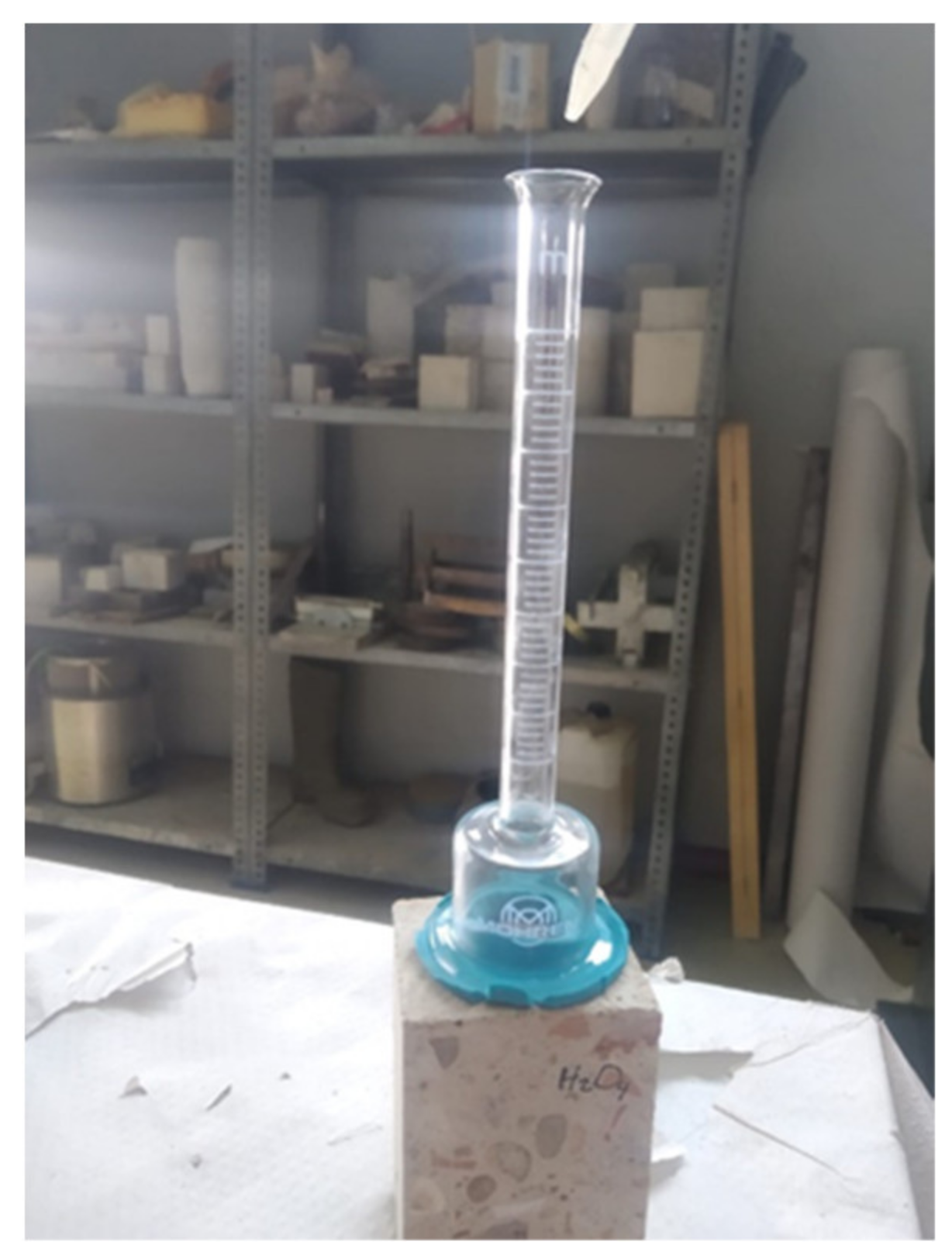
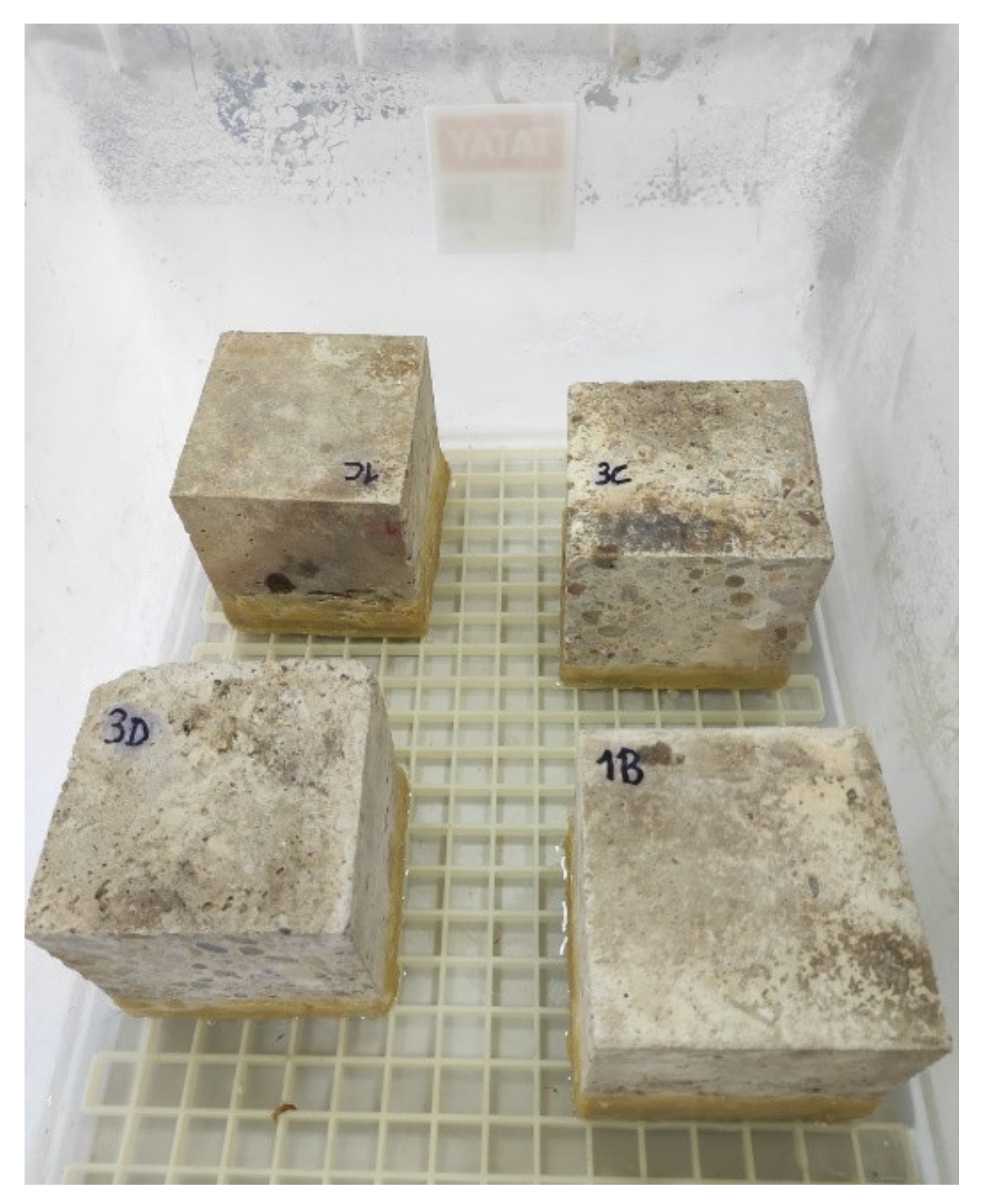
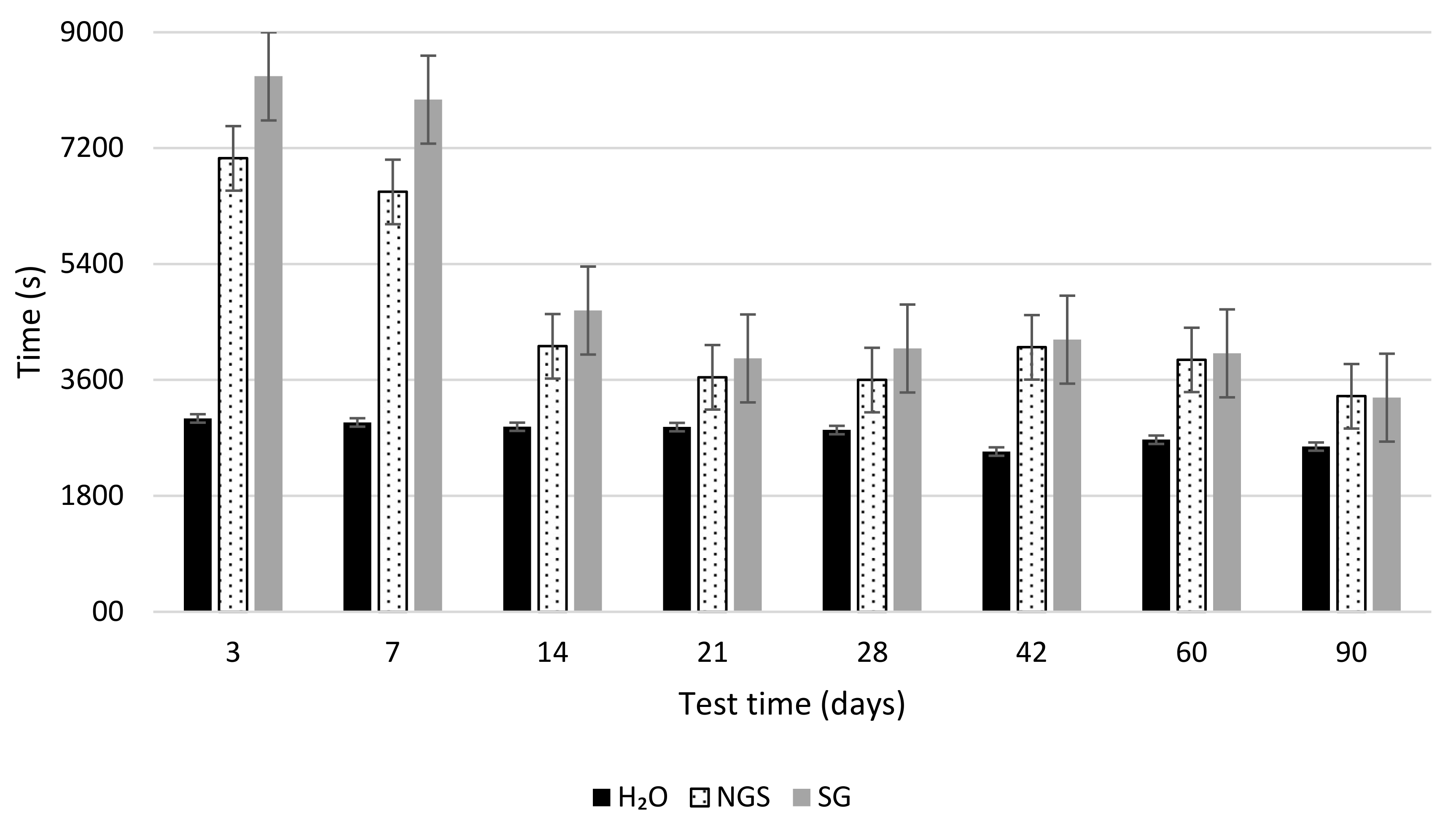
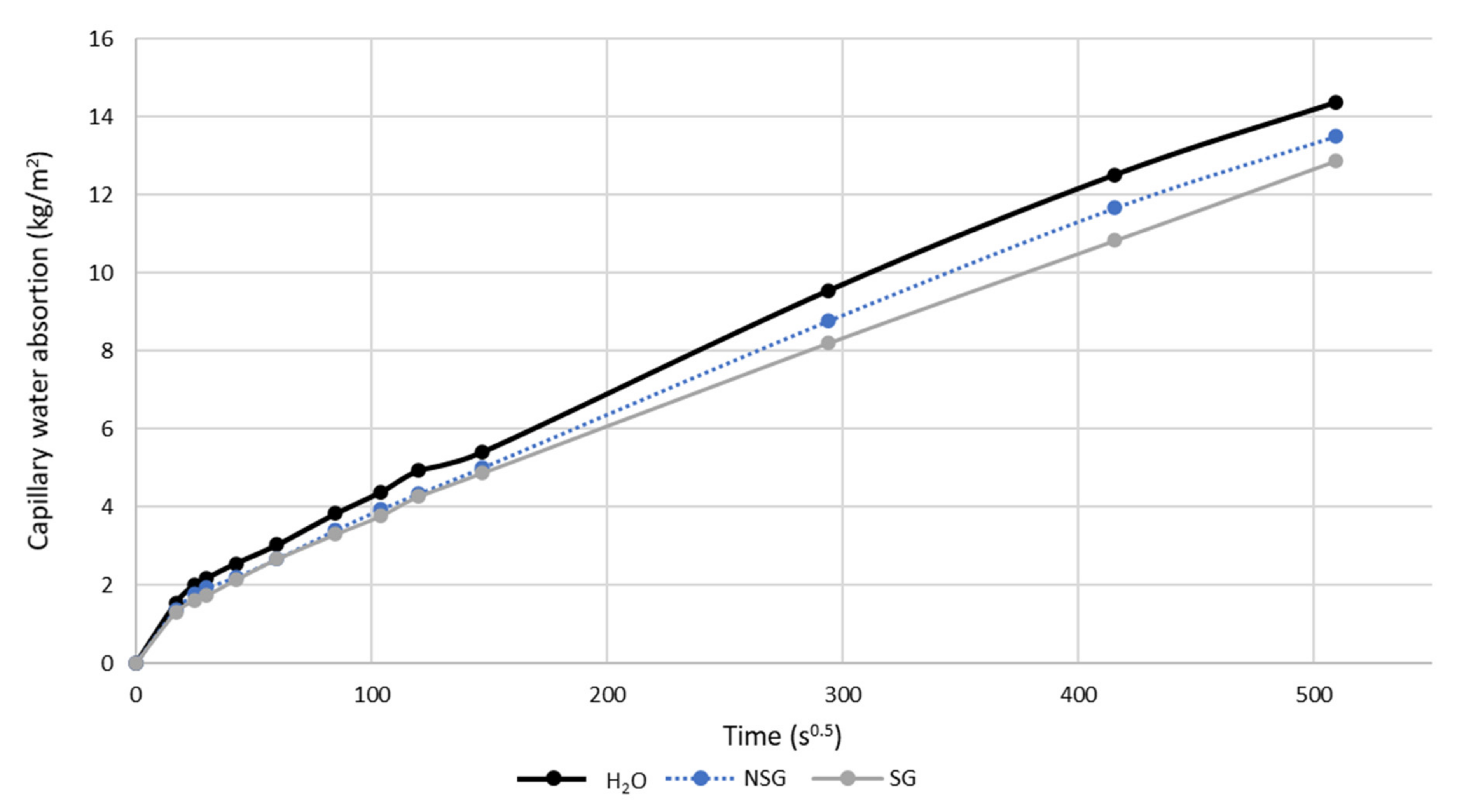

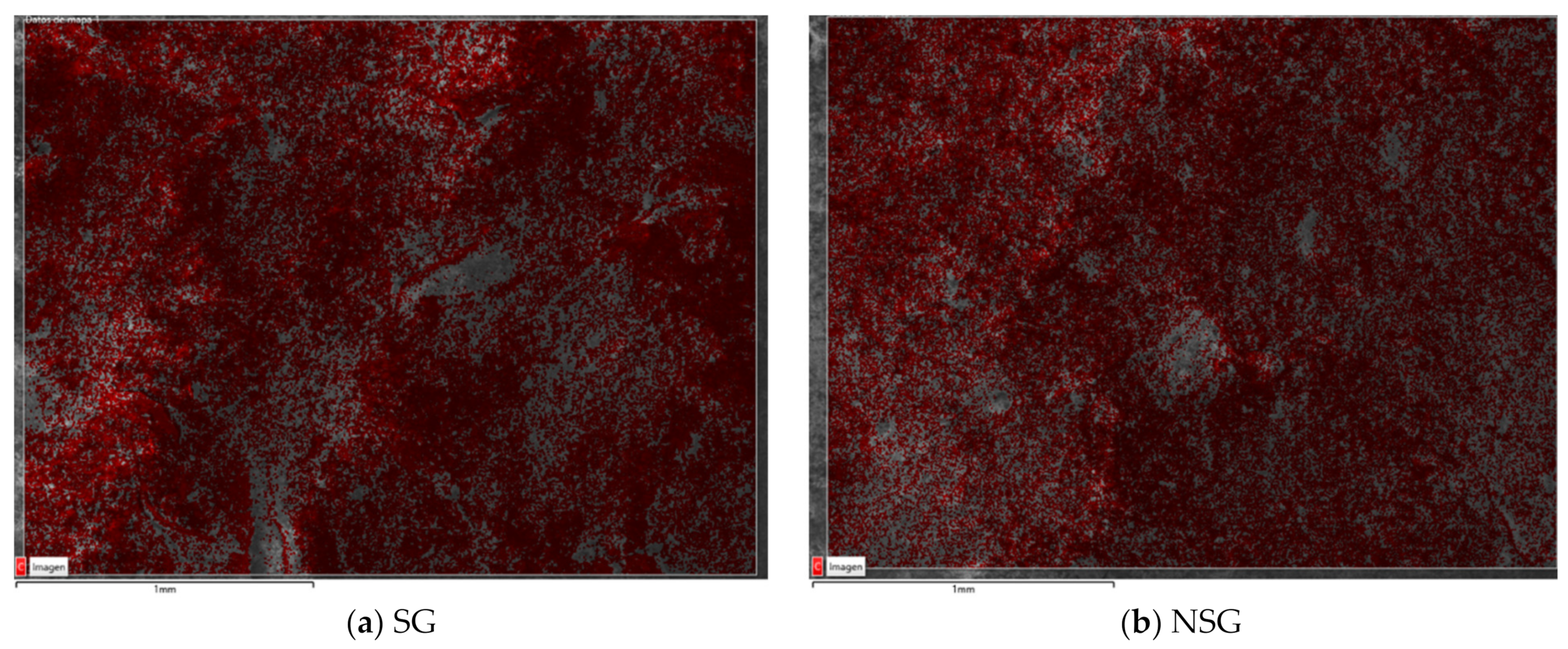
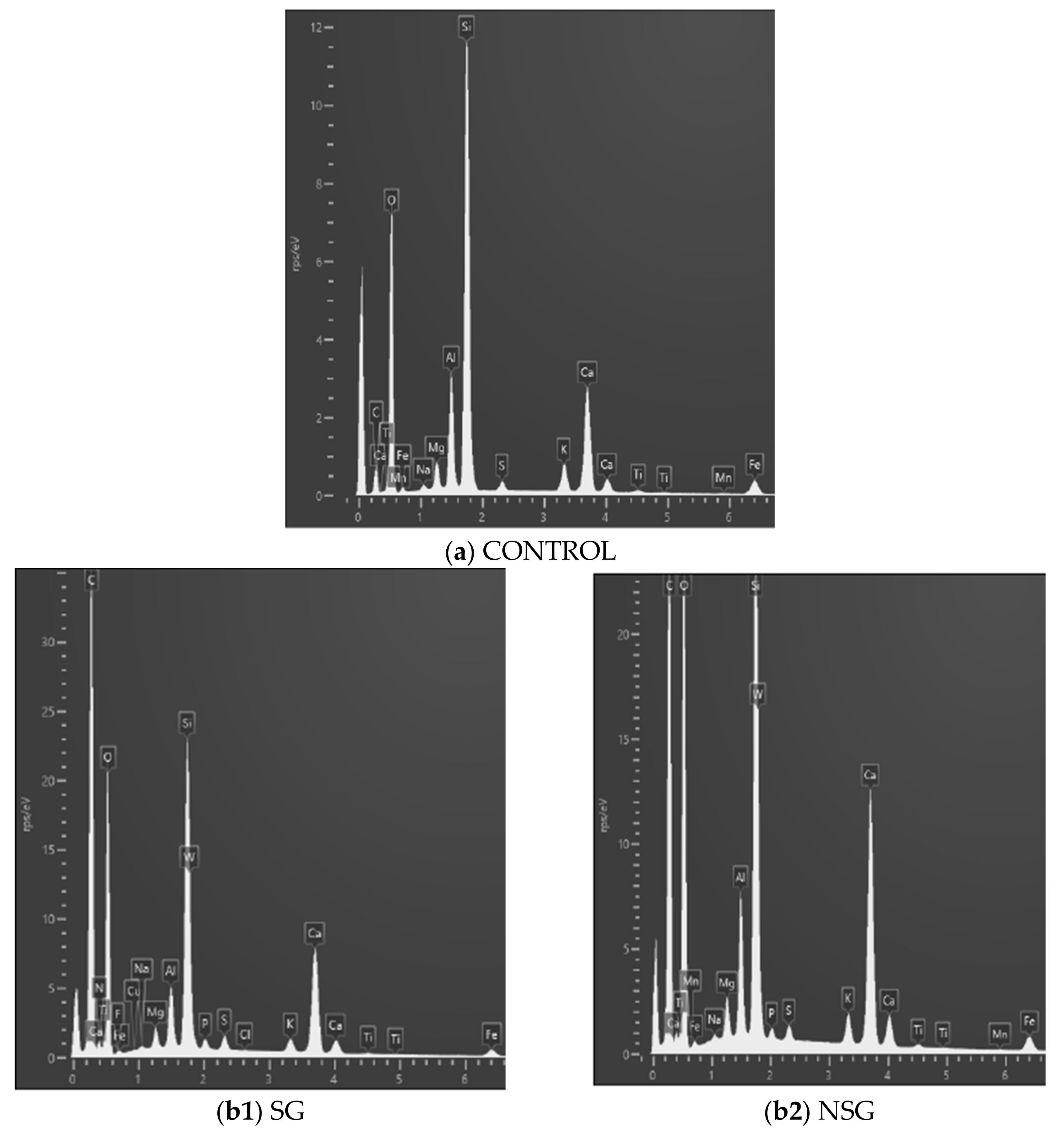
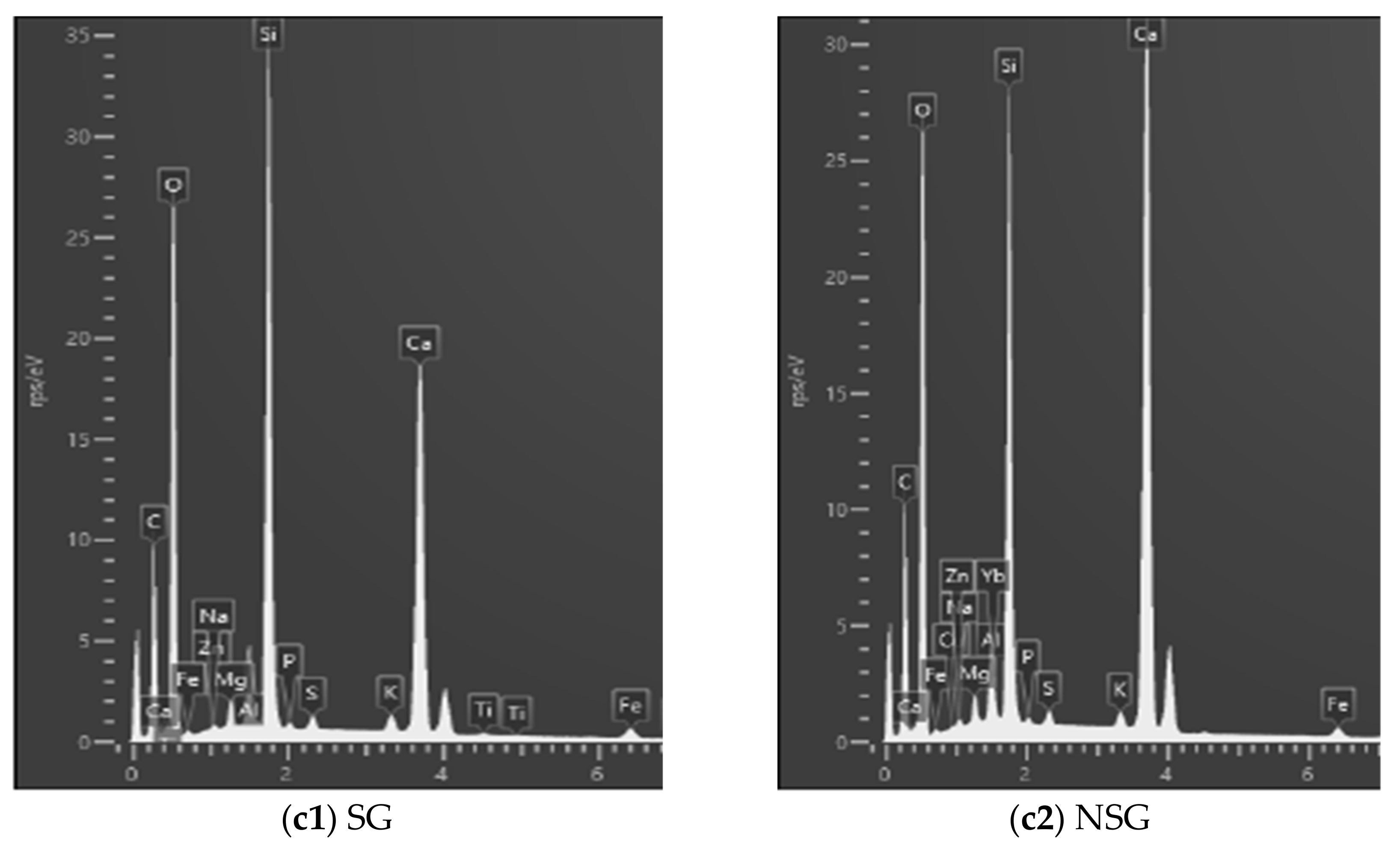
| Materials | Composition (m3) |
|---|---|
| Water (L) | 215 |
| Cement (kg) | 391 |
| Sand (kg) | 716 |
| Gravel (kg) | 447 |
| MRA (kg) | 447 |
| Components of MRA | % (wt) |
|---|---|
| Unbound aggregate (natural aggregate with no attached cement mortar) | 17.5 |
| Masonry and fired clay (bricks, tiles, stoneware, sanitary ware…) | 33.6 |
| Concrete and mortar (natural aggregate with bound cement mortar) | 44.1 |
| Asphalt | 0.4 |
| Glass | 0.8 |
| Gypsum | 3.5 |
| Other impurities (wood, paper, metals, plastic…) | 0.1 |
| Treatments | Capillary Water Absorption Coefficient (kg m−2 min0.5) | Standard Deviation |
|---|---|---|
| H2O | 4.57 × 10−4 | 4.05 × 10−5 |
| NSG | 3.91 × 10−4 | 3.84 × 10−5 |
| SG | 3.78 × 10−4 | 3.57 × 10−5 |
| Elemental Relative Content (%) | |||||
|---|---|---|---|---|---|
| Specimens | C | O | Ca | Si | Al |
| Control | 10.0 | 47.0 | 8.90 | 20.80 | 5.3 |
| NSGbefore test | 44.3 | 36.1 | 6.70 | 7.80 | 2.0 |
| NSGafter test | 21.5 | 46.1 | 19.3 | 9.30 | 1.4 |
| SGbefore test | 49.0 | 33.1 | 4.10 | 6.20 | 1.3 |
| SGafter test | 25.4 | 45.3 | 12.5 | 12.6 | 1.5 |
Publisher’s Note: MDPI stays neutral with regard to jurisdictional claims in published maps and institutional affiliations. |
© 2021 by the authors. Licensee MDPI, Basel, Switzerland. This article is an open access article distributed under the terms and conditions of the Creative Commons Attribution (CC BY) license (https://creativecommons.org/licenses/by/4.0/).
Share and Cite
Serrano-González, L.; Merino-Maldonado, D.; Guerra-Romero, M.I.; Morán-del Pozo, J.M.; Lemos, P.C.; Pereira, A.S.; Faria, P.; García-González, J.; Juan-Valdés, A. Use of Bioproducts Derived from Mixed Microbial Cultures Grown with Crude Glycerol to Protect Recycled Concrete Surfaces. Materials 2021, 14, 2057. https://doi.org/10.3390/ma14082057
Serrano-González L, Merino-Maldonado D, Guerra-Romero MI, Morán-del Pozo JM, Lemos PC, Pereira AS, Faria P, García-González J, Juan-Valdés A. Use of Bioproducts Derived from Mixed Microbial Cultures Grown with Crude Glycerol to Protect Recycled Concrete Surfaces. Materials. 2021; 14(8):2057. https://doi.org/10.3390/ma14082057
Chicago/Turabian StyleSerrano-González, Lorena, Daniel Merino-Maldonado, Manuel Ignacio Guerra-Romero, Julia María Morán-del Pozo, Paulo Costa Lemos, Alice Santos Pereira, Paulina Faria, Julia García-González, and Andrés Juan-Valdés. 2021. "Use of Bioproducts Derived from Mixed Microbial Cultures Grown with Crude Glycerol to Protect Recycled Concrete Surfaces" Materials 14, no. 8: 2057. https://doi.org/10.3390/ma14082057
APA StyleSerrano-González, L., Merino-Maldonado, D., Guerra-Romero, M. I., Morán-del Pozo, J. M., Lemos, P. C., Pereira, A. S., Faria, P., García-González, J., & Juan-Valdés, A. (2021). Use of Bioproducts Derived from Mixed Microbial Cultures Grown with Crude Glycerol to Protect Recycled Concrete Surfaces. Materials, 14(8), 2057. https://doi.org/10.3390/ma14082057







